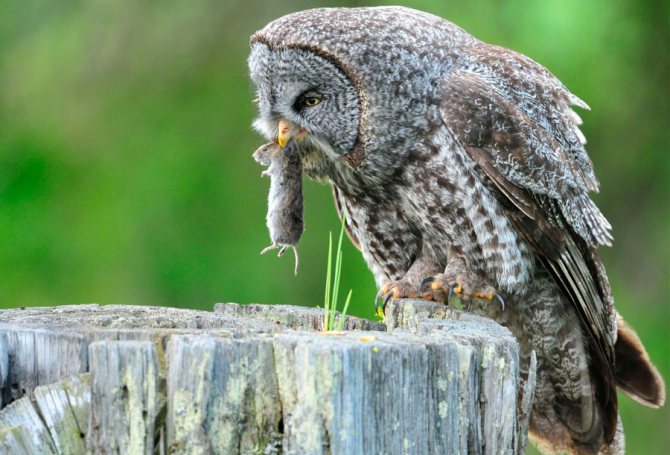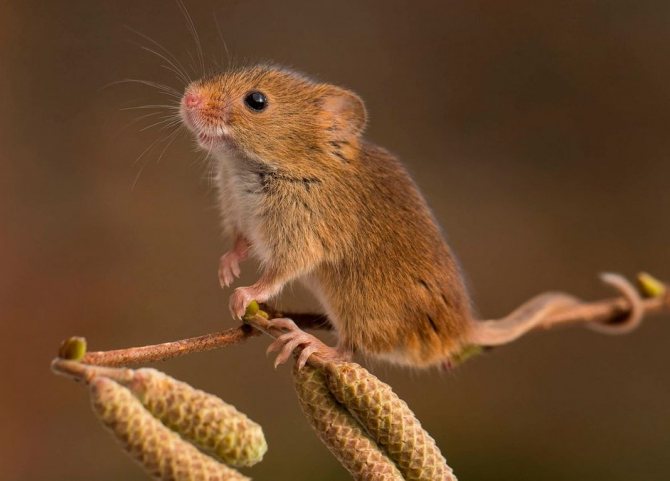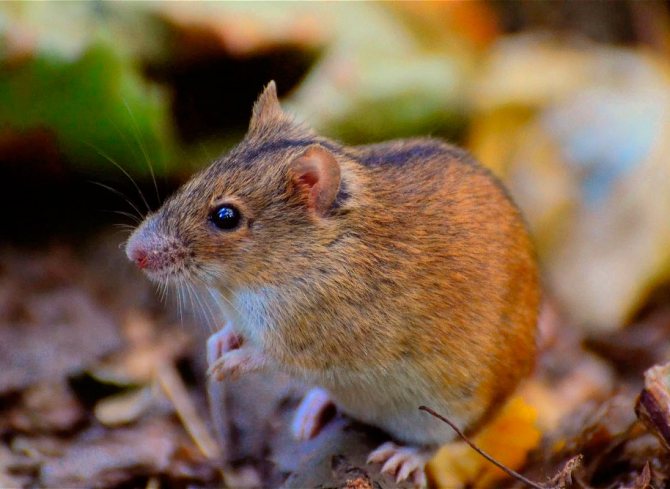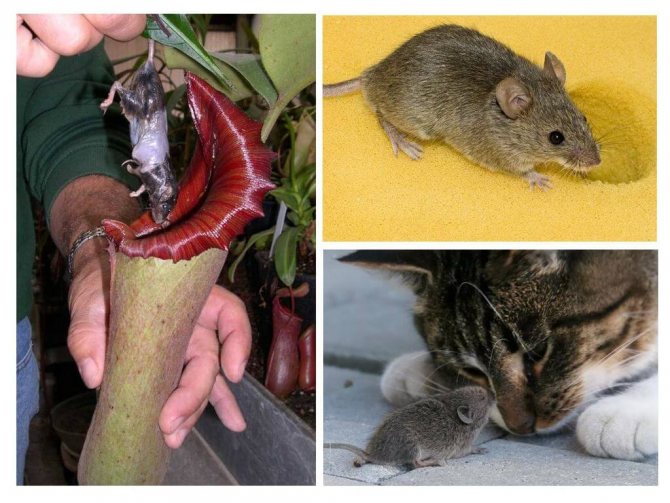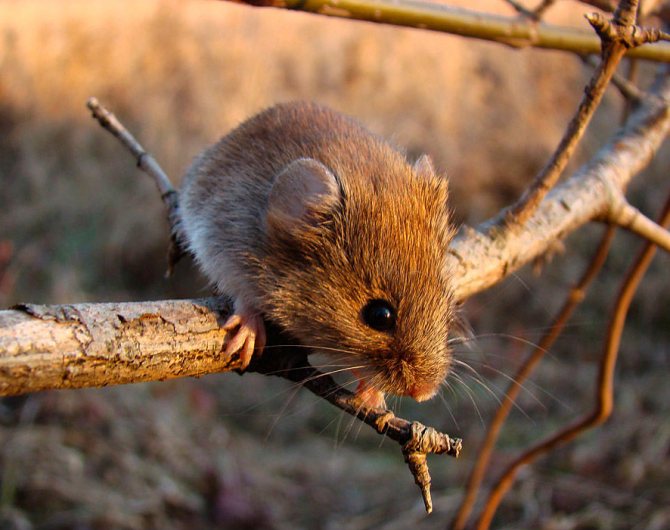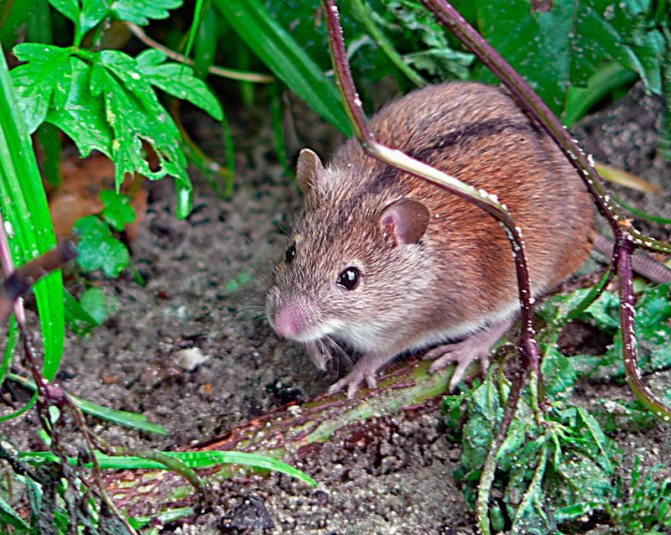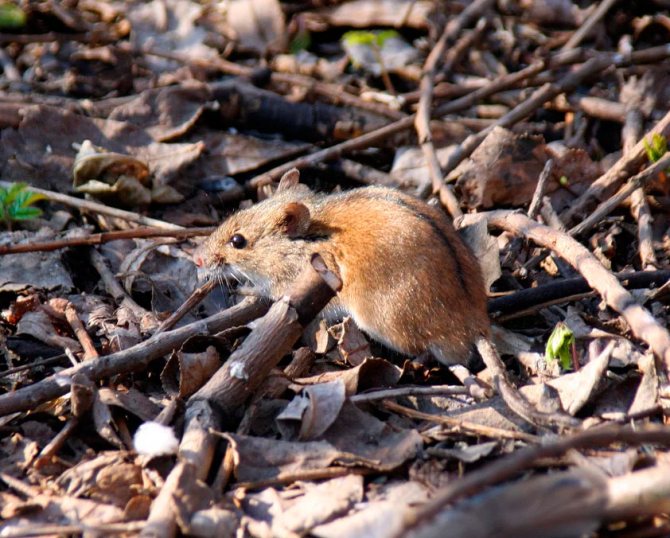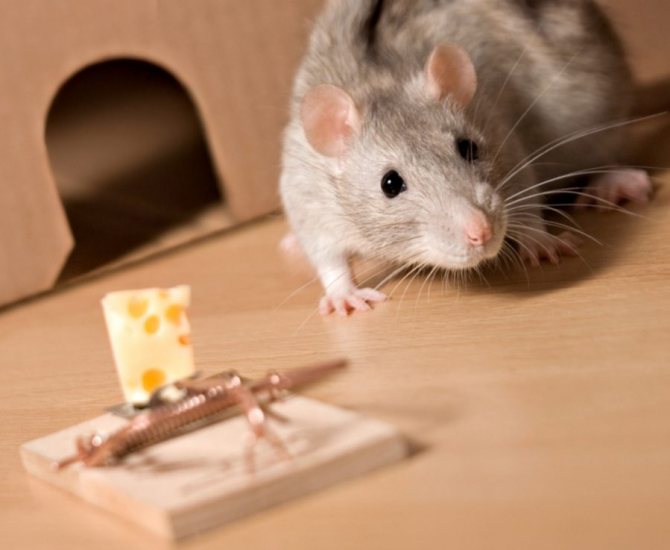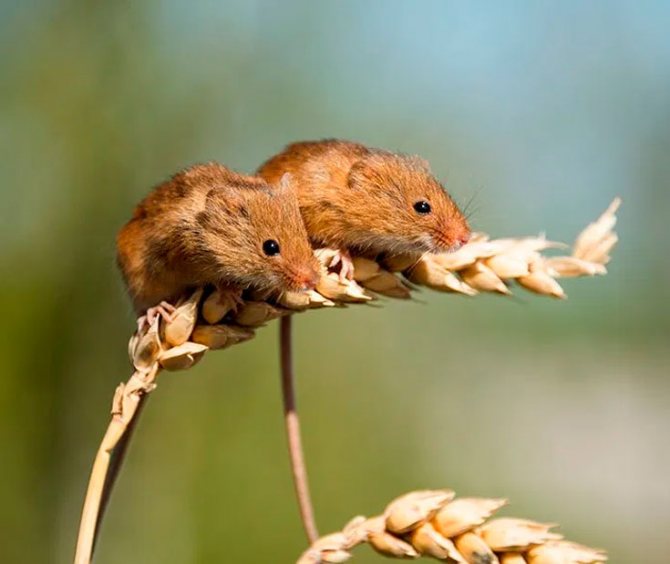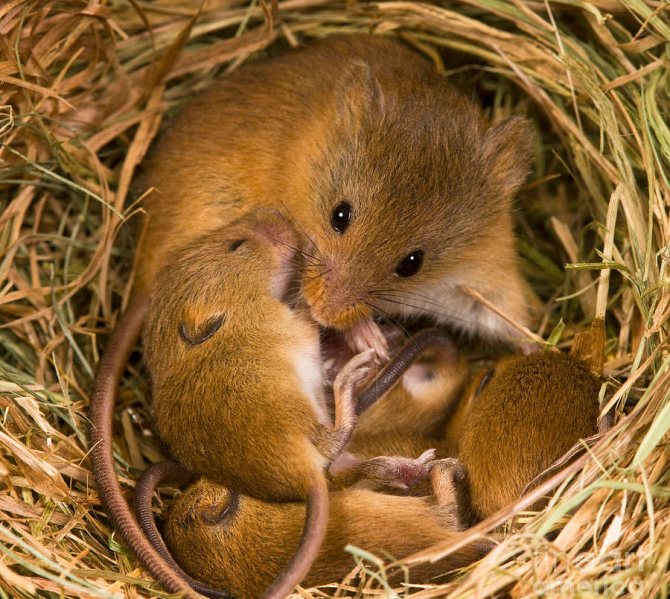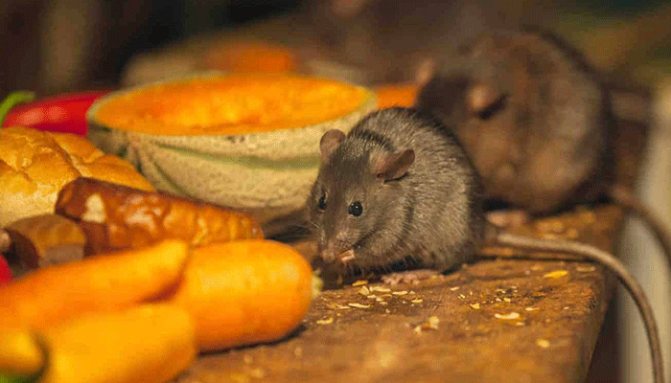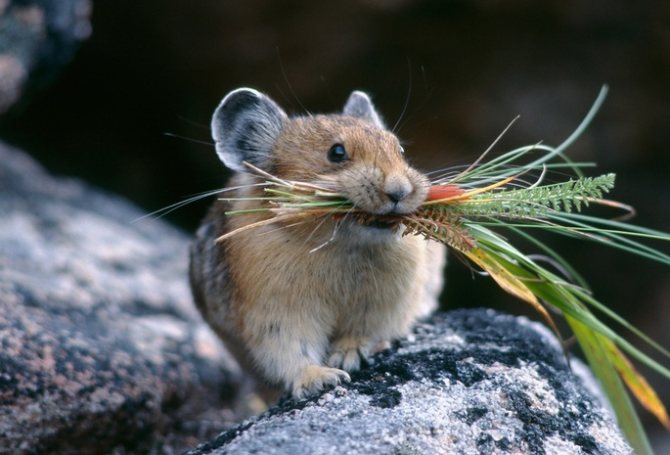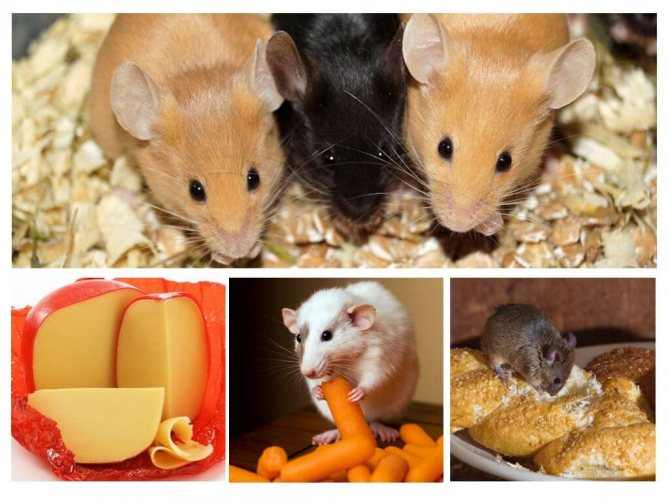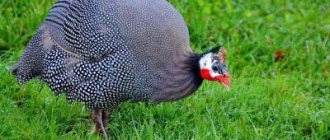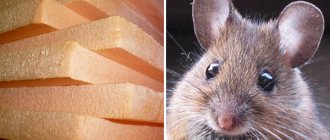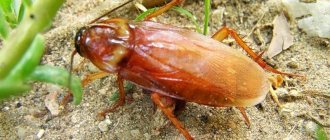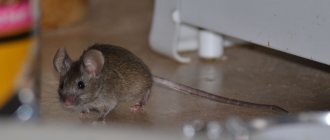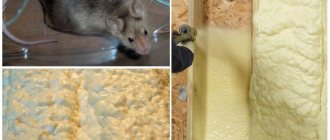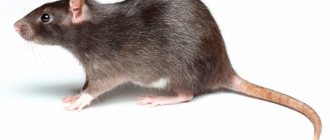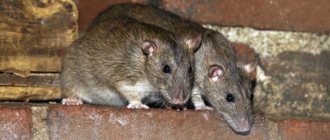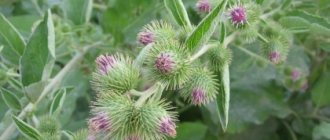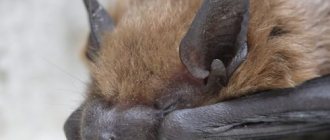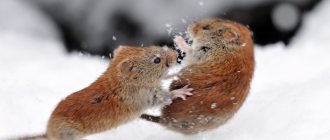Mice are small rodents with a pointed elongated muzzle, large ears and round eyes. A distinctive feature of these animals is a long, slightly drooping tail without hair. The mouse family includes about 400 species of animals.
The body length of an adult is no more than 20 cm, weight is up to 50 g. Rodents are omnivorous, widespread everywhere, except in the highlands and northern regions. Some people have warm feelings for them, so they turn them on at home. Let's consider in detail what mice like to eat in different living conditions.
Habitat and diet of wild rodents
Mice live on all continents. Together with humans, they settled around the world and adapted to different climatic zones. Rodents thrive in the tropics, mountains, and swamps. They are able to survive at a stunning height: 4 thousand meters is not the limit for these little creatures.
Usually mice settle near human settlements. This applies primarily to the brownie and the Cairo variety. Indeed, in cities and villages, at every step, you can find what the mouse eats. Therefore, here she is as comfortable as possible. But if natural disasters occur - fires, floods or earthquakes, rodents are able to leave their habitat and migrate.
Those species that live in steppes or forests do not swim well. But marsh mice feel free on the water. Rodent houses are of three types:
- simple minks;
- complex holes in the form of labyrinths;
- nests of grass stalks.
Mice are terrestrial. They rarely climb trees, but they easily climb small bushes.
They usually like plant-based foods. These can be the fruits of trees, bushes, grass seeds. Sometimes mice feast on insects. Those species that live in meadows and fields feed on grains, stalks of cereals and seeds. Inhabitants of swamps and river banks willingly eat plants, especially their green part. Various buds, roots, shoots and leaves make up their daily menu.
What does a mouse eat if it is a resident of the forest? The answer is simple - everything that trees can give her. These can be cedar and beech fruits, as well as hazel, nuts and acorns. The biggest gluttons, of course, are domestic mice. In people's apartments there is everything for them the most delicious: cheese, sausage, cereals, eggs. Some rodents eat their own kind.
So, large yellow-throated mice feed on individuals of smaller sizes: forest or field. But this is if they are locked in a cage or one room. In the wild, these species coexist peacefully, and there have been no cases of cannibalism between them. This is due to the fact that small mice are more mobile. Catching them in an open space is not always possible.
Looking at the photo of a field mouse or a domestic one, you can see that these animals are small. And like all small animals, they have an increased metabolism, so they eat often and a lot. During the ripening period of the crop, animals can cause enormous damage to agriculture, since they are forced not only to satisfy their daily gluttony, but also to prepare winter supplies.
The barrow house mouse is very interesting in this regard. She lives in the fields of Ukraine, Moldova and Hungary. When the harvest is in progress, she picks up the fallen spikelets and grains of cereals and carries them to the burrow. Here the products are stacked in the form of a slide.Every day this hill grows, turning over time into a rick, which reaches 80-100 centimeters in height and two meters in length. Then they camouflage this hill with earth. Because of this feature, they were called kurganchikovs.
We suggest that you familiarize yourself with: Do alcoholics have worms
The habitat of mice covers almost all climatic zones, continents and belts, the only exception is Antarctica. Their various types are found in forests, in the taiga, in the tropics, steppes or swamps. Therefore, what such animals eat depends on the habitat and environment.
The smallest mice, such as shrews, can be only 5 cm in length, and there are some that grow up to 50-80 cm.The color can also vary: ranging from white, gray, brown and up to black. Females become fertile at the age of 6 weeks and are capable of giving birth to 5-10 babies in each litter.
In natural conditions, mice feed on what they find around: seeds of cereals brought from agricultural fields (wheat, barley, oats, etc.), small insects or their larvae. Living in burrows, the mouse in the meadow eats not only grain, but also clover and green parts of plants.
Wild wild mice eat berries and fruits of plants, as well as nuts, mushrooms, acorns, and tops. Swamp dwellers prefer to feed on various parts of plants: buds, roots, leaves and shoots. They eat caterpillars and grasshoppers with no less pleasure.
The construction of nests and the filling of bins continues until the onset of frost. In the cold season, field mice eat what they have accumulated in their burrows, and often eat small insects, worms, crickets, beetles and their larvae.
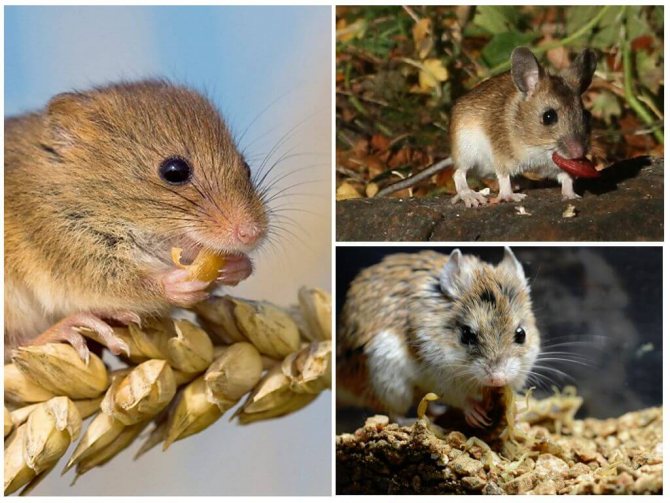
Food for rodents in nature
Very important in their diet is the presence of water, which they need up to 3 ml per day for normal life. Consuming only dry food without water, these animals die within 2 weeks.
Cannibalism is very rare among small pests. Large mice eat mice only in a situation when they are closed in a confined space or when an unfamiliar individual appears in the team. In the wild, various species exist quite peacefully.
However, the fact that these animals eat their own kind is reliable when raising offspring. Most often this occurs from a lack of vitamins and malnutrition of the mother, as well as the birth of an unviable baby or too many offspring that the mother is not able to feed and is forced to eat.
Rat - description, appearance and characteristics. What does a rat look like?
Rats have an oval body shape characteristic of most rodents and a stocky build. The body length of an adult rat is from 8 to 30 cm (depending on the species), the weight of a rat varies from 37 g to 420 g (individual gray rats can weigh up to 500 grams).
The rat's muzzle is elongated and pointed, the eyes and ears are small. The tail of most species is practically naked, covered with sparse hair and ring scales.
The tail of a black rat is covered with thick hair. The tail length of most species is equal to or even greater than the body size (but there are also short-tailed rats).
Black rat tail
The rodent's jaws contain 2 pairs of elongated incisors. Rat molars grow in dense rows and are designed to grind food. Between the incisors and the molars is the diastema - the area of the jaw where teeth do not grow. Despite the fact that rats are omnivorous, they are distinguished from predators by the absence of fangs.
The incisors of animals need constant grinding, otherwise the rat simply cannot close its mouth. This feature is due to the absence of roots and the continuous growth of incisors throughout the life of the animal.In front of the incisors are covered with hard enamel, but behind there is no enamel layer, so the surface of the incisors grinds off unevenly and takes on a characteristic chisel-like shape. The teeth of rats are extremely strong and can easily gnaw through bricks, concrete, hard metals and alloys, although they were originally intended by nature for the consumption of plant foods.
The rat's coat is dense, relatively thick, with a pronounced guard hair.
The color of the rat's fur can be dark gray, gray-brown; in the color of some individuals, reddish, orange and yellow shades can be traced.
In rats, calluses on the paws are poorly developed, which are necessary for rodents to climb, but the functional deficiency is compensated for by movable fingers.
Therefore, rats are able to lead not only a terrestrial, but also a semi-arboreal lifestyle, climbing trees and equipping nests in abandoned hollows.
Rats are very mobile and hardy animals, they run well: in case of danger, the animal develops a speed of up to 10 km / h, overcoming obstacles up to 1 meter high. The daily exercise of the rat is from 8 to 17 km.
Rats swim and dive well, catch fish and can continuously stay in the water for more than 3 days without harm to health.
Photo by: Kristyna Burgerova
Vision in rats is poor and has a small viewing angle (only 16 degrees), which forces the animals to constantly turn their heads. Rodents perceive the world around them in gray tones, and red is a continuous darkness for them.
Hearing and smell function well: rats perceive sounds with a frequency of up to 40 kHz (for comparison: humans up to 20 kHz), and smells catch at short distances. On the other hand, rats tolerate radiation exposure well (up to 300 roentgens / hour).
The lifespan of a rat in the wild depends on the species: gray rats live about 1.5 years, rare specimens can live up to 3 years, black rats live no more than a year.
In laboratory conditions, the life of a rodent is doubled. According to the Guinness Book of Records, the oldest rat at the time of death was 7 years and 8 months old.
Eating near a person's home
In search of affordable food, mice very often move to live closer to human habitation, because here they can find a lot of food leftovers without unnecessary effort. A vole that lives near a person's house, with the coming of night, in search of edible food, eats and steals everything:
- food left over after dinner;
- cereals stored in kitchen cabinets;
- potatoes and other root vegetables stored in the cellar;
- the remains of vegetables, berries and fruits, green parts of plants;
- seedlings intended for the garden, etc.;
- rodents living near the apiary often eat honey and bee bread, which causes a lot of trouble for beekeepers.
We suggest you read: Poisoned Grain for Mice
Mice living in a house or apartment are usually omnivorous and eat everything they can find in the kitchen, on the table, in the pantry or in the trash can.
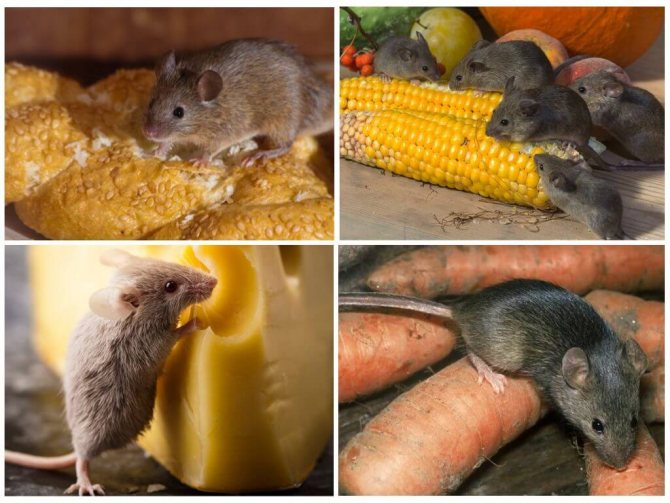

Feeding mice in a human house
Habits and behavior
Where mice live, there are usually many treats for them to covet. Escaping from their dwelling at night, they steal everything that lies badly: seeds, berries and other foodstuffs. But during the day they can often be seen on the surface, especially in late August - early September, when the harvest is ripe and you need to stock up on food for the winter.
These animals are very careful. They are rather shy, they always listen to all kinds of sounds. If they feel threatened, they hide or run away. They run very fast. The common mouse, as well as representatives of other species, communicate with each other using a squeak. They can live both singly and in small groups. Families unite in the fall to joint efforts to stock up on food for the winter.
Scientists answer
Scientists from the UK were interested in the question of why mice love cheese.They conducted a number of experiments with mammals.
- Apple;
- chocolate.
The results showed that the mice were eating cheese. with this delicacy, and they loved to run there most of all. And chocolate did not arouse interest among animals at all.
It is likely that different and different varieties of treats were involved in the experiment, which is why the results are so different from each other.
On a note!
Disinsectors, however, assure that it is worth taking sunflower seeds, flour, wheat, unrefined oil as bait. Pests love such food more.
What do domestic mice eat?
Rodents living at home have the widest diet. A person who maintains decorative mice at home must independently take care of what they will eat.Many owners buy ready-made feeds that are selected in terms of the content of flavoring and nutritional elements, are balanced in their composition.
When self-feeding, it should be borne in mind that the basis of the diet of mice is vegetable food:
- cereals: wheat, rye, corn, barley, a small part of oats;
- sunflower seeds, various types of nuts, however, an excessive content of vegetable protein can cause obesity and liver disease;
- vegetables, berries and fruits;
- greens: dill, parsley, wheat germ, dandelion leaves, etc.
Animal products that mice eat:
- raw eggs, preferably quail;
- finely chopped boiled or raw meat;
- cottage cheese and white cheese;
- Many owners recommend feeding the mice with mealworms once a month.
Available delicacies: bread, dried fruits.
It is strictly forbidden to give to rodents:
- fried, salty and spicy;
- sweet "snacks";
- milk, because intolerance to this product is common;
- beets, tomatoes, cabbage and citrus fruits;
- peeling potatoes;
- food for cats and dogs, although many mice love them for some reason;
- medicinal herbs, especially bitter ones: wormwood, celandine, etc.
By choosing wholesome food and what the mouse eats in the cage, its owner will be able to provide the pet with a comfortable and long-term existence.
Poison bait
Distinguish between bait-delicacies (for a trap, lure into live traps and electric traps) and poisoned baits. For a particular type, you need to choose the right products. So, the base for the poisonous filling must be mixed with the active substance until smooth.
The bases for the preparation of mouse poison can be porridge, dough, mashed potatoes, flavored with sunflower or sesame oil. Toxins are mixed with them - Krysid, Zoocoumarin, Ratindan.
Interesting! Zoocoumarin and Ratindan are anticoagulant-based poisons. Refers to long-acting poisons. The mouse dies from internal bleeding, but this lasts from three days to two weeks. Along the way, the toxin causes the animal to suffocate, so it tries to get out of the room into the air. However, there is no guarantee that the mouse will not crawl to die in some deep passage, where its corpse will subsequently exude a disgusting smell. Therefore, it is better to lay out the poison with Zoocoumarin in traps to prevent the pest from escaping. Krysid is a quick poison, rodents die of pulmonary edema right at the site of eating the poison. However, mice and rats learn quickly and begin to recognize this poison - in the end they refuse the bait.
Also food base can be beer (mice love him very much, and rats will not pass by), raw fish or minced meat, boiled egg (finely chopped).
The stronger the base of the poisonous bait smells, the more reliably it masks the smell of the toxic substance. However, beer requires the use of additional containers (bowls), which is not very convenient. Therefore, the number one basis for the manufacture of poison will be raw minced meat. In second place - porridge and puree seasoned with sesame oil.
A poisonous agent is mixed into the base in doses corresponding to the instructions. The finished poison is placed in a trap, liquid - in a saucer.
Work on the preparation of the poisonous bait should be in thick rubber gloves. This is necessary not only to protect the hands, but also to prevent the human smell on the bait (one of the main mistakes in the fight against rodents).
Of course, it is much easier and safer to buy ready-made mouse bait in a specialty store than to tinker with homemade poisons. The assortment is varied: granules, poisonous grain, dough briquettes. There are ready-made poisons for rats and mice.
It remains only to fill the traps with poison.
Important! Traps are set along the path of rodents. They walk along the perimeter of the room, along the walls - they do not cross the center. Mice do not get far from their shelters, twenty meters is the maximum range of their travels. With this in mind, traps are set. Another useful feature of the mouse character for humans is that they are curious, so any new object in the forage area attracts their attention and the rodents themselves.
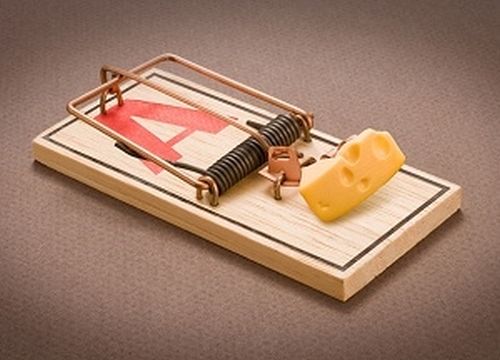

Poison baits are a good way to catch and punish pests, but not ideal. Because, nevertheless, the risk is not excluded that the dying rodent will go deep into its shelter and die there with the emission of a corpse smell afterwards.
Interesting! More preferred electronic traps are now being offered. They are also equipped with baits, the attracted animal goes inside and instantly kills it with an electric shock. No torment, no smell and no blood. Charging the device is enough for 100 hits, which is suitable for food warehouses, large production areas. However, the devices are quite expensive, and besides, they cannot be used unattended outside (due to the threat of rain).
What do mice eat in captivity?
Some people are crazy about domesticated, tamed rodents. Usually these are individuals of small size, white in color. They are easy to train, get used to a person and easily cohabit with him. What does a white mouse eat? Yes, everything, anything. It can be a variety of feeds that are produced by the industry.
They are balanced with mineral supplements and grains, so that your pet develops properly and always remains healthy. If you want to feed your animal with real food, you can give it different grains and cereals. Fatty and spicy foods should be excluded. Feed your baby raw mealworm meat once a week.
Domestic mice are fed once a day. Do not exceed the dosage of food, otherwise the rodent may get sick. The features of each variety are described in the encyclopedia. After reading it, you will learn in detail what the white mouse eats. Based on the information received, you can correctly form the pet's diet so that it is always healthy, active and lives next to you for many years.
We suggest you familiarize yourself with: Wormwood from fleas in cats and dogs
Reproduction
Mice are very fertile. They have no special marriage rituals. The male simply smells the female by smell, finds her and mates. Sometimes there is a rivalry between males and a fierce fight for the right to fertilize.
After a short pregnancy, a mouse gives birth to three to ten mice. They develop very quickly, and after three months they can bear offspring. Each female can give birth 3-4 times a year, so the rodents reproduce very rapidly. The most interesting thing is that some species live together in whole family clans, like people. In one mink, young mice successfully coexist, forming pairs, together with their parents.
In nature, predators regulate the rodent population. The wide distribution of animals throughout the territory of a certain area makes them easy prey for foxes, forest cats, birds of prey and snakes. If there is hunger in the forest, then even wolves and coyotes do not disdain mice. In their natural habitat, animals usually live for 7-9 months.
At the same time, in captivity, mice can last as much as 5 years.Therefore, they can become your life companions for years. If you are still in doubt whether to buy rodents for your home or not, then look at the photo of a field mouse. These cute animals will charm you with their innocence and cute appearance, and their rapid reproduction can even become your business and generate income.
Rodent damage
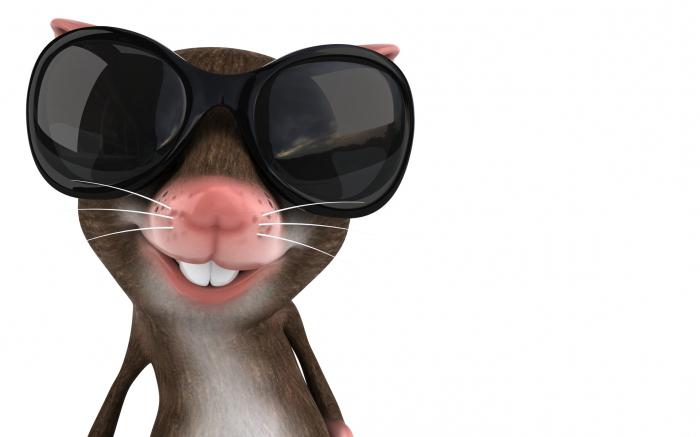

Knowing what the mouse eats, we can easily conclude why its habitation in the house or in the field is unprofitable for humans. Understandably, humans are reluctant to share their food supplies with rodents. Therefore, they try in every possible way to get rid of the unwanted neighborhood when they find their traces in storerooms and barns.
In addition to stealing food, animals also leave their droppings everywhere, so it is no longer possible to use a bag of cereals in which the pests ruled. Rodents also spoil the bark of fruit trees, which can lead to the death of seedlings. In Africa, for example, mice completely destroy coffee plantations, causing enormous damage to people.
Rodents carry many diseases. The most dangerous in this regard are not brownies, but field mice. Their feces and urine contain dangerous bacteria that can enter the human body and provoke an epidemic of pseudotuberculosis, hemorrhagic fever, tick-borne encephalitis and other fatal ailments.
A bit of history
Who knows where this myth originated from. Most likely, traces go back to the Middle Ages. Before the invention of the refrigerator, it was much more difficult to store food, therefore everyone got out of the situation as best he could: the meat was fastened on a hook under the ceiling, the grain was kept in bags or barrels, and large circles of cheese were covered with wax or wrapped in linen.
In those days, a hungry mouse was willing to eat anything. Meat hanging from the ceiling was harder to reach, and wheat or cheese was much easier to access. Here are just the loss of several grains from the bag is not so noticeable, and on a piece of cheese you can see traces of teeth. Perhaps this led many to believe that mice are very fond of cheese. Even if in fact they only eat it because it turned out to be their only prey.
Benefit
It's hard to overestimate it. And first of all, it again comes from what the mouse feeds on. Insects are the basis of the diet of some species. By eating them, the rodent saves humanity from harmful and annoying insects, which can often also be carriers of viruses. At the same time, being a delicacy for foxes and owls, they make their existence possible.
The benefit of mice for humanity lies in the fact that these animals are often used in laboratory experiments. Vaccines and medicines are tested on them, which in the future will bring great benefits to humanity. In addition, these animals are excellent pets that do not require special care. Even the smallest child can look after pets. Being unpretentious and small, and also easy to train, they will become favorites for your whole family.
Main food
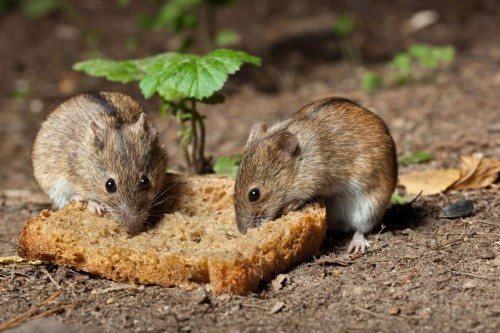

The damage done by murine rodents can be colossal. These animals are incredibly voracious and can destroy a significant part of crops in a short time. Their appetite is explained by the peculiarities of metabolism: a large amount of energy is spent on maintaining body temperature at the required level. During the day, one mouse can eat an amount of grass that exceeds its own weight three times.
The main food for small rodents is the juiciest and youngest shoots of plants, mainly cereals. In summer, when breads are ripening in full swing, mice eat grains, and in winter, fruit trees are threatened - their bark and roots are the favorite food of rodents.

